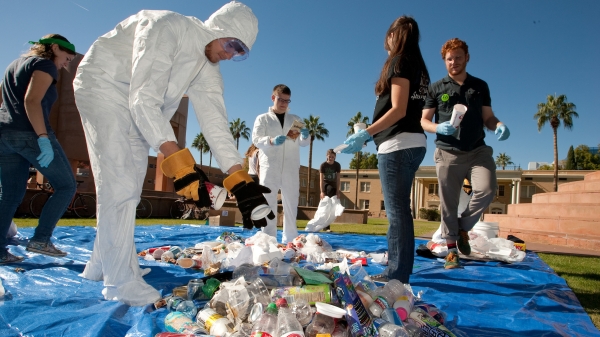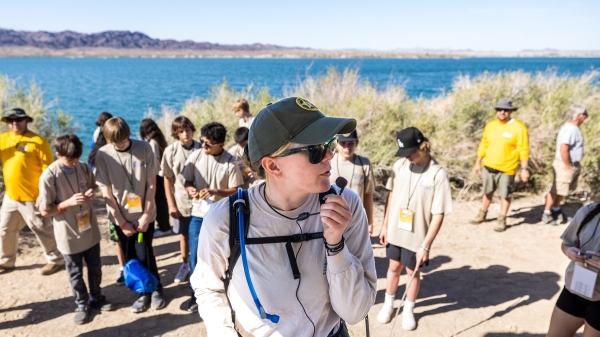Six Arizona State University energy-related research projects that will engage veterans or active-duty military are getting support from the Navy in the form of $1.5 million in seed grants over two years.
ASU’s LightWorks InitiativeASU LightWorks pulls light-inspired research at ASU under one strategic framework. It is a multidisciplinary effort to leverage ASU's unique strengths, particularly in renewable-energy fields including artificial photosynthesis, biofuels and next-generation photovoltaics. announced the funding through the Office of Naval Research’s Naval Enterprise Partnership Teaming with Universities for National Excellence (NEPTUNE) pilot program.
Each of the projects include a component that involves military members, with the goal of providing experience, skill training and resume building that will benefit them in their post-military careers.
There will also be program engagement designed to impact the ASU veteran community and — to the greatest extent possible — local bases with active-duty military personnel. ASU’s NEPTUNE program will work with the Pat Tillman Veterans Center to reach out to the more than 4,000 veterans enrolled at ASU, as well as military personnel from local bases.
Energy issues are both technology and people challenges, and the newly funded projects recognize that.
“People are an important part of alternative energy systems,” said Bill Brandt, director of strategic integration for ASU LightWorks and lead principal investigator of the projects. “Practical input from veterans with hands-on experience in military operations is critical to use-inspired energy innovation for the U.S. Navy.”
In exchange for participation in various meetings and workshops, veteran students will have the opportunity for independent-study credit hours, co-authorship of publications and other resume-building experiences. Participants will also build their career networks through corporate mentorship.
Engagement will include critical skills training in entrepreneurship, project management, leadership, technology to market and engineering problem solving.
The six NEPTUNE-funded research projects will contribute to new knowledge including training veterans to design and manage resilient energy systems. The projects are:
Self-organizing microgrids
The “grid” is the basic electric power infrastructure — power plants, transmission lines and power storage devices — by which our electricity is delivered. Microgrids can be disconnected from the grid, perhaps after a disaster or during extended military missions, and still provide electricity. This project will improve the way microgrids integrate with the grid and with each other to increase reliability and efficiency while lowering cost.
Remote sensing for smart renewable power
Renewable wind energy is generated only when the wind blows. The wind does not blow consistently, and it doesn’t always blow hardest when electricity demand is highest, so energy providers must turn to stored energy or backup generation. This project will use a cloud- and wind-detecting tool called 3D Scanning Doppler LIDAR to predict wind-energy generation, allowing energy providers to balance their sources for a more reliable supply.
Energy leadership informatics
For the military and many other organizations, including those in the energy sector, leadership makes decisions based on available data. If more data on how people interact with energy systems can be collected and assessed in a short time, this can improve the decision-making process. This project will deploy computational tools designed to improve operational performance and safety. Insights gained from the assessment will inform decisions and help promote institutional change.
Positive resilience case studies
Most energy infrastructure systems have plans to withstand and recover from disaster. When systems fail, there is deep scrutiny. We all learn from these failures. But we can also learn from positive outcomes where catastrophe was avoided. This project will assess positive case studies to define the characteristics of resilient systems, and will include such factors as organizational communication and consumer-driven response.
Monitoring underwater conditions
Optical communications technology uses light, rather than sound, to send and receive data. Traditional acoustic methods that use high-bandwidth radio frequencies cannot go underwater. This project will advance the use of optical communications technology to monitor underwater conditions. In the future, optical networks may replace underwater cables over high-risk sections of the sea floor and form sensing perimeters around ships and other structures.
Cyber threats to critical infrastructure
A sixth project capitalizes on the university’s Global Security Initiative and will focus on preventing and responding to cyberattacks on critical energy infrastructure.
“Many of ASU’s greatest points of pride are represented in this project — use-inspired research, fusing intellectual disciplines, enabling student success, veteran engagement and sustainability,” said Gary Dirks, director of ASU LightWorks and the Julie Ann Wrigley Global Institute of Sustainability at ASU. “These are the strengths that ASU brings to the Navy project.”
ASU LightWorks is a unit of the Julie Ann Wrigley Global Institute of Sustainability.
More Environment and sustainability

Confusion complicates US recycling efforts
In most major cities and buildings, recycling bins can often be found alongside trash bins in an effort to encourage recycling. But is it working? According to the U.S. Environmental Protection…

ASU empowers students to build a thriving global future
At Arizona State University, leadership has made tremendous efforts to create programs and initiatives aimed at supporting a healthy planet and thriving future for all life — and now, more than ever…

Colorado River becomes an outdoor classroom for these middle school students
Griffin Freburg doesn’t usually look forward to science class. But on a sunny day in March, the eighth grader changed his tune. Concepts that were usually explained in long paragraphs in a textbook…
